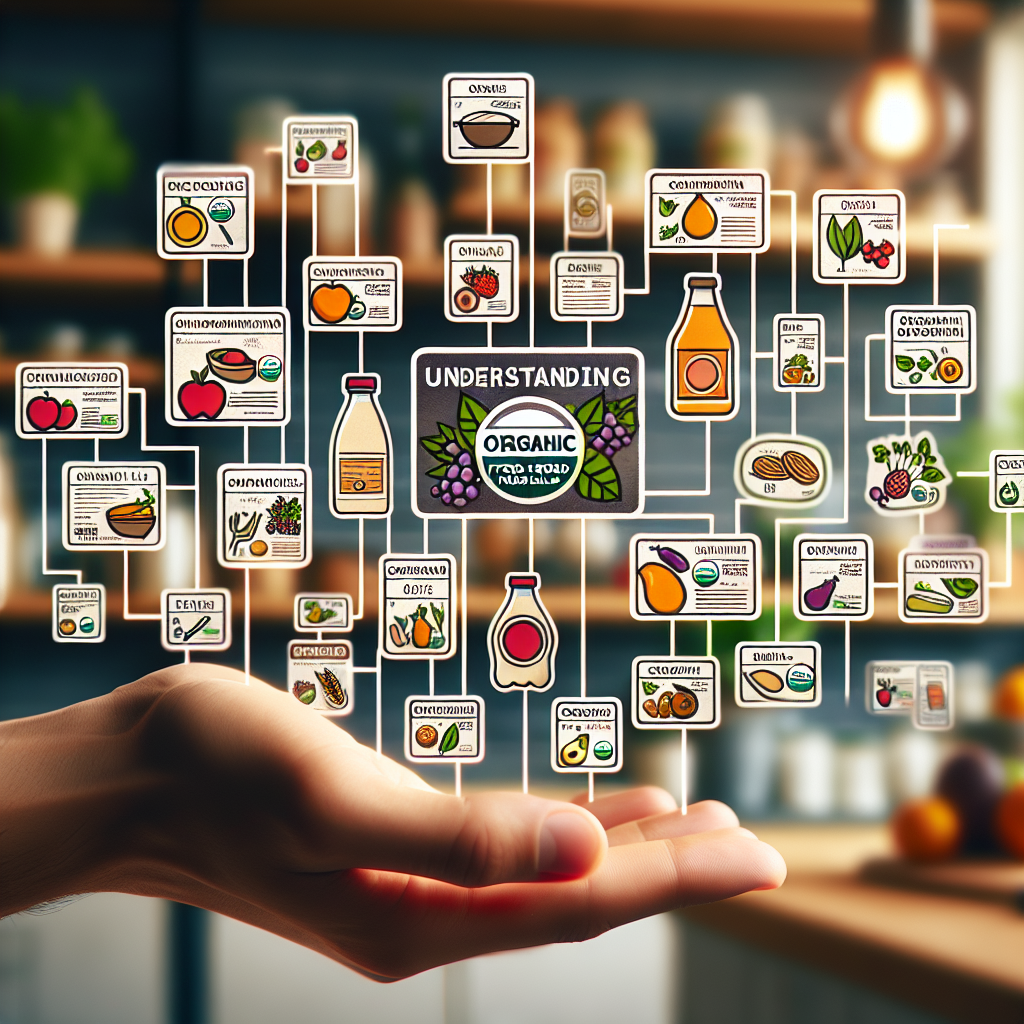
Understanding Organic Certification
What Does Organic Really Mean?
When diving into the world of organic food, the first thing that strikes me is the authenticity of the term “organic.” To me, it signifies that the food has been produced without synthetic fertilizers, pesticides, and genetically modified organisms (GMOs). Bottom line? It’s all about going back to basics and promoting sustainable farming practices.
This distinction is crucial for consumers like us. We’ve come to trust this label because it’s enforced by regulatory bodies that ensure these standards are met before granting certification. For example, in the U.S., the USDA oversees this process, making it a more reliable choice when shopping.
Understanding this can help us make informed choices, proving that choosing organic isn’t just about trends—it’s also about health and environmental stewardship.
==> Click Here for the best Certified Organic Product available - at a huge discount!
Types of Organic Labels
You’ve probably seen various labels on the packaging, right? Terms like “100% Organic”, “Organic”, and “Made with Organic Ingredients” can be quite confusing. Each label indicates a different level of organic content. Personally, I find that knowing the difference empowers me during grocery runs.
“100% Organic” means that all elements in the product are organic. On the other hand, “Organic” typically means at least 95% of the ingredients are organic. Meanwhile, “Made with Organic Ingredients” suggests that at least 70% of the contents come from organic sources. These details matter, and they can change how I perceive a product’s quality.
So, the next time you’re staring at the shelves, you’ll know what’s up with these labels, making your decision-making a whole lot easier!
The Importance of Third-Party Verification
I think we all can agree that having someone check the credentials of our food is super important. Third-party verification plays a vital role in the organic food sector. Companies can’t just claim they’re organic; they need to pass rigorous inspections. These inspections include evaluation of their farming practices, ensuring they comply with organic standards.
This verification gives me peace of mind when I’m purchasing organic products. Knowing that a neutral party has ensured the integrity of these practices helps build confidence in what I’m consuming. This isn’t just a marketing gimmick; it’s a necessity that protects both farmers and consumers.
Next time you buy organic, spot the certification seal—it’s there for a reason and ensures the product meets legitimate organic standards.
Deciphering Labels: A Consumer’s Guide
Key Terms You Should Know
In my adventures of mastering organic food labels, I found several key terms that pop up frequently. Terms like “no added hormones,” “free-range,” or “grass-fed” can be enticing, but what do they really mean? Each label provides insights into the farming practices behind the scenes.
For instance, when I see “grass-fed,” I know that the animal’s diet consisted mainly of grass rather than grain, which translates to healthier fats for me—to each their own! Understanding these terms allows us to make even more informed choices about what we put into our bodies.
It’s a little like unlocking secrets in the food world. The more you know, the better choices you can make, and who doesn’t want that?
Reading the Ingredient List
A crucial step that often gets overlooked is carefully reading the ingredient list. I can’t tell you how many times I’ve reached for “organic” only to find some sneaky non-organic ingredients hiding in there! Ingredients are often listed in descending order of weight, so the first few will comprise the bulk of what you’re eating.
==> Need an Energy Boost? Click Here for the best Organic Product available - at a huge discount!
This is where critical thinking comes into play. Even if a product isn’t entirely organic but contains organic ingredients, it’s important to understand what those ingredients are. It’s all about being an informed consumer, right?
In my experience, getting into the habit of scrutinizing ingredient lists turns grocery shopping into a fun little challenge rather than a burden. If it looks good, eat up! But if the list strays into the complicated territory—or contains preservatives and fillers—it’s a big “nope” from me.
Checking for Freshness
Another tip I love to share is checking for freshness! Organic food can often be more perishable compared to conventional options, partly due to the lack of preservatives. When I’m shopping, I always check the expiration date, but I also look for signs of freshness—vivid colors, firmness in fruits and veggies, and proper packaging can indicate the product’s quality.
This vigilance ensures that I’m getting the best possible organic produce that truly lives up to its label. A great deal on a wilted organic spinach is never worth it. Trust me, freshness plays a massive role in taste and nutrition!
Next time you’re out shopping, play detective and examine the freshness of your organic finds; it makes a world of difference in your meals.
Thank you for Your Interest!
==> Click Here for the best Organic Nutrition Product available (with a great discount)!
Common Myths About Organic Foods
Organic Equals Pesticide-Free?
A common misconception I’ve encountered is that organic means ”pesticide-free.” While it’s true that organic farming doesn’t allow synthetic pesticides, it does allow the use of certain natural pesticides. Educational moments like these have helped me understand that “organic” doesn’t equate to “free from all chemicals.”
Understanding this has also influenced my choice of food. Natural pesticides might still be less harmful than their synthetic counterparts. The key here is being diligent about educating ourselves around the nuances of organic farming practices.
So, the next time someone tells you organic food is pesticides-free, you can enlighten them with facts. It’s all about sharing what we learn with others, right?
Organic Foods are Always Healthier
Another fave myth I’d like to debunk is the idea that all organic foods are inherently healthier. While organic foods do avoid synthetic additives, some organic snacks are still high in sugars, sodium, and fats. When I hear someone say organic equals healthy, I smile, knowing that balance is key.
It’s essential to treat organic foods just like any other foods: evaluate their nutritional content and make informed decisions based on your dietary needs. I discovered long ago that being mindful, regardless of whether food is organic or not, leads to better health outcomes.
Ultimately, eating healthy is about balance, and that includes getting a variety of foods into our diets—organic or not!
Organic Foods are More Expensive for a Reason
Lastly, let’s chat about the price tag that’s often attached to organic foods. It’s not just snobbery; the processes behind organic farming tend to be more labor-intensive and sustainable. Understanding this aspect has shifted my perspective on why I might pay a little more for that organic apple versus a conventional one.
I think of it as investing in my health and supporting sustainable farming practices that can lead to a better environment, and that’s worth a few extra bucks. It becomes more clear when I phrase it as valuing what I consume rather than just comparing prices.
So, when I hear someone grumbling about organic prices, I share how that cost is a reflection of the care and effort put into those products. It’s a conversation worth having!
Final Thoughts: Making Choices with Confidence
Overall, mastering organic food labels is a fantastic journey that encourages us to be more mindful about what we eat. Understanding certifications, deciphering labels, and shedding light on some myths equip us with the knowledge needed to make informed decisions.
I encourage you to be curious and continue learning. The world of organic foods is vibrant and full of variety; exploring it means you’re taking charge of your health while supporting a more sustainable planet.
Next time you hit the grocery store, remember these tips, and you’ll approach organic food shopping with a whole new perspective. Let’s share our discoveries and keep the conversation rolling!
Frequently Asked Questions (FAQ)
-
What is the difference between “organic” and “100% organic”?
“100% Organic” means the product consists entirely of organic ingredients, whereas “Organic” typically consists of at least 95% organic ingredients. The distinction matters when you’re looking for pure products versus those that contain a mix.
-
Are organic products always healthier?
No, not necessarily. While organic foods avoid certain synthetic additives, some organic items can be high in sugars or unhealthy fats, just like conventional foods. It’s essential to read labels and nutritional information.
-
Can organic foods still contain pesticides?
Yes, organic foods can be treated with natural pesticides, which are not synthetic but may still have some chemical properties. So it’s a bit of a misconception that organic equals pesticide-free.
-
Why are organic foods more expensive?
Organic foods often require more labor-intensive farming methods and adhere to strict standards, which can drive up costs. This is an investment in sustainable practices and your health.
-
How can I identify fresh organic produce?
To ensure freshness, check for vibrant colors, firm textures, and avoid any packaging that looks damaged or dated. Also, always look for expiration dates when buying packaged organic foods.
==> Thank you for reading this post! Click Here for the best Organic Product available – at a huge discount!
Related Content
- The Ultimate 2025 Guide to the Best Organic Fruit and Veggie Nutrition Strategies
- Why Switching to Organic Stone Fruits Can Enhance Your Health
- 10 Effective Organic Meal Replacement Strategies for 2025
- 7 Reasons Why Organic Foods Might Not Be Working for You
- How Certified Organic Nutrition Leads to Sustainable Weight Loss

